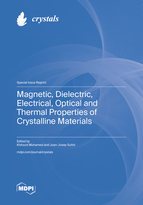Magnetic, Dielectric, Electrical, Optical and Thermal Properties of Crystalline Materials
A special issue of Crystals (ISSN 2073-4352). This special issue belongs to the section "Crystalline Metals and Alloys".
Deadline for manuscript submissions: closed (30 November 2023) | Viewed by 39704
Special Issue Editors
Interests: nanostructure; metallic and alloys; mechanical alloying; ECAP process; microstructure; magnetic property
Special Issues, Collections and Topics in MDPI journals
Interests: powder metallurgy; structural analysis; thermal analysis; mechanical alloying; nanocrystalline
Special Issues, Collections and Topics in MDPI journals
Special Issue Information
Dear Colleagues,
Several fields of application have already made use of crystalline materials which combine a variety of remarkable physical features, including chemical stability, inexpensive production costs, and magnetic, dielectric, electrical, optical, and thermal characteristics. However, these materials are frequently utilized in magnetic data storage, magnetic imaging, drug delivery, microwave devices, and environmental protection, whether they are in the form of bulk or nanomaterials. These nanocrystalline materials' suitable and functional performance may be influenced by factors such as fine particle size, shape, capping, surfactant, doping, and structure of defects, among many others. Furthermore, numerous chemical, physical, and mechanical techniques can be used to create such materials with specified physical and chemical properties for a particular purpose.
This Special Issue titled "Magnetic, Dielectric, Electrical, Optical and Thermal Properties of Crystalline Materials" is devoted to a general overview of the subject of crystalline materials and may extend to the nanocrystalline field. Applications, synthesis, and characterization of these materials, as well as the investigation of their structural, magnetic, dielectric, electrical, optical, and thermal properties, are all of interest.
Prof. Dr. Khitouni Mohamed
Prof. Dr. Joan-Josep Suñol
Guest Editors
Manuscript Submission Information
Manuscripts should be submitted online at www.mdpi.com by registering and logging in to this website. Once you are registered, click here to go to the submission form. Manuscripts can be submitted until the deadline. All submissions that pass pre-check are peer-reviewed. Accepted papers will be published continuously in the journal (as soon as accepted) and will be listed together on the special issue website. Research articles, review articles as well as short communications are invited. For planned papers, a title and short abstract (about 100 words) can be sent to the Editorial Office for announcement on this website.
Submitted manuscripts should not have been published previously, nor be under consideration for publication elsewhere (except conference proceedings papers). All manuscripts are thoroughly refereed through a single-blind peer-review process. A guide for authors and other relevant information for submission of manuscripts is available on the Instructions for Authors page. Crystals is an international peer-reviewed open access monthly journal published by MDPI.
Please visit the Instructions for Authors page before submitting a manuscript. The Article Processing Charge (APC) for publication in this open access journal is 2100 CHF (Swiss Francs). Submitted papers should be well formatted and use good English. Authors may use MDPI's English editing service prior to publication or during author revisions.
Keywords
- crystalline materials
- nanocrystalline
- structural properties
- magnetic properties
- dielectric properties
- electrical properties
- optical properties
- thermal properties
Benefits of Publishing in a Special Issue
- Ease of navigation: Grouping papers by topic helps scholars navigate broad scope journals more efficiently.
- Greater discoverability: Special Issues support the reach and impact of scientific research. Articles in Special Issues are more discoverable and cited more frequently.
- Expansion of research network: Special Issues facilitate connections among authors, fostering scientific collaborations.
- External promotion: Articles in Special Issues are often promoted through the journal's social media, increasing their visibility.
- Reprint: MDPI Books provides the opportunity to republish successful Special Issues in book format, both online and in print.
Further information on MDPI's Special Issue policies can be found here.







